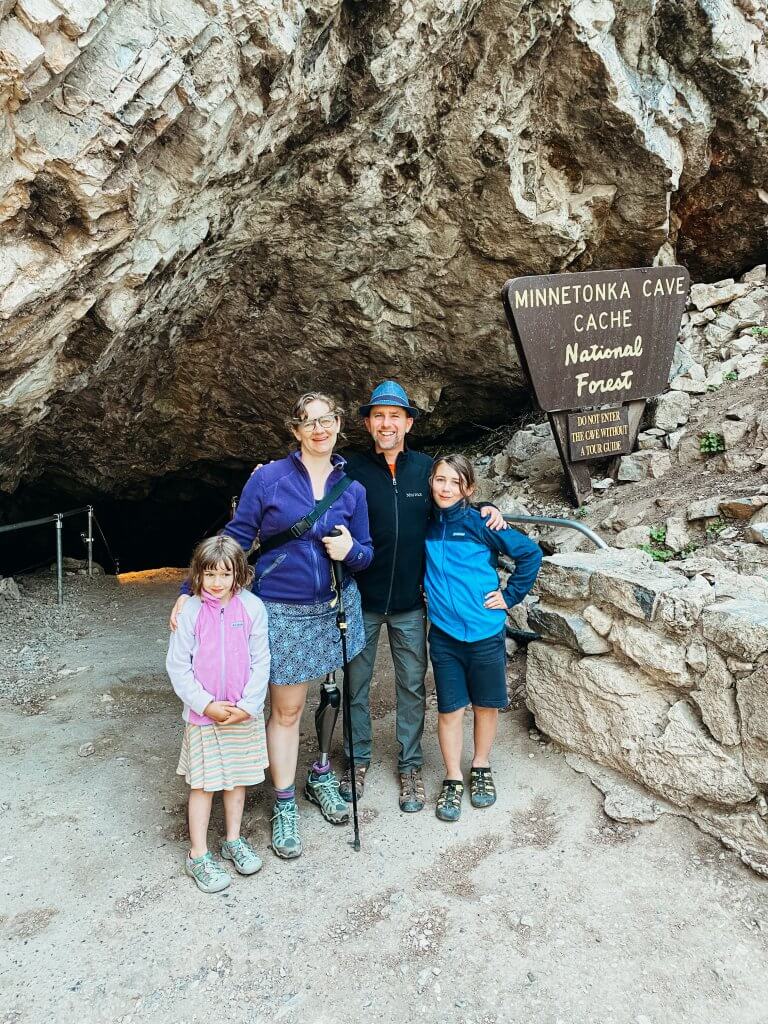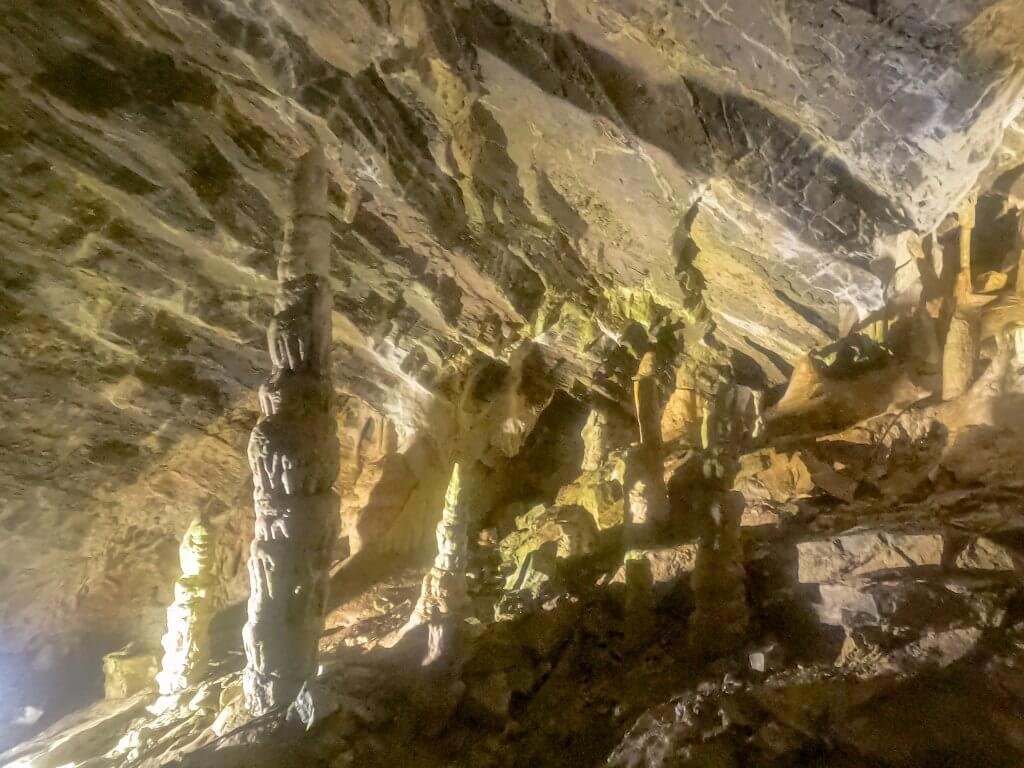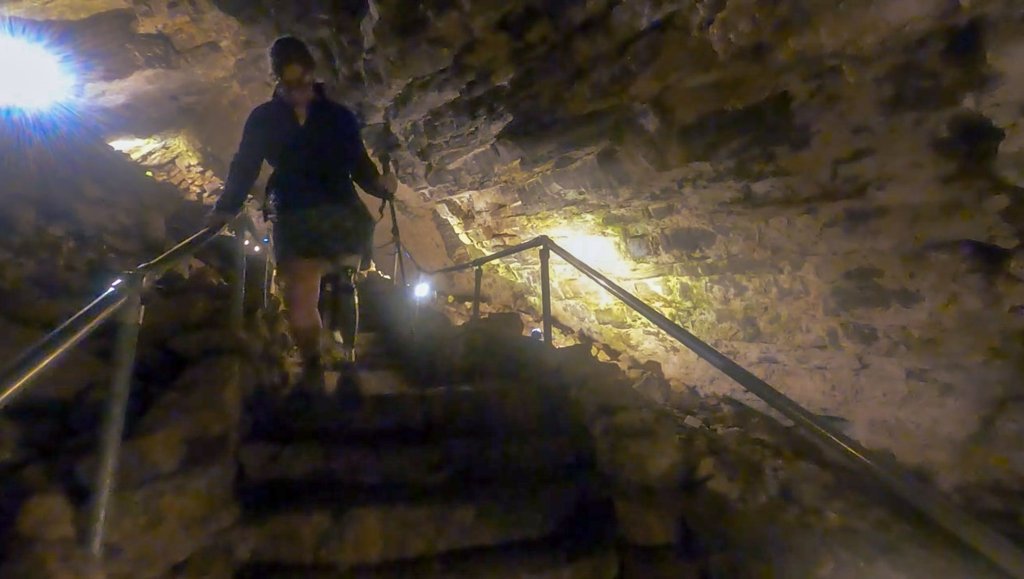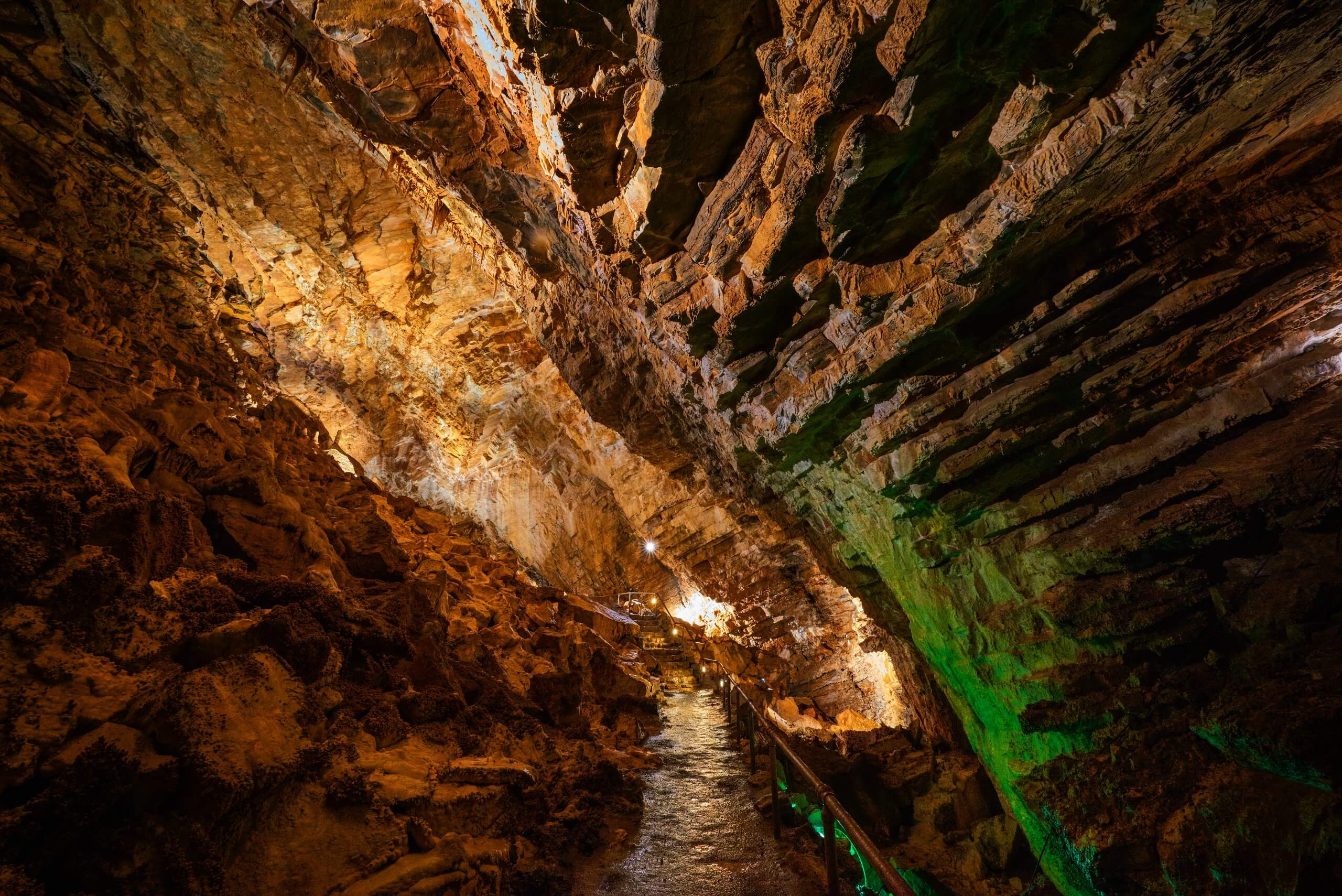Learners and Makers worked in partnership with Visit Idaho to create this Travel Tip.
Minnetonka Cave had us at bacon.
Idaho’s largest cave is one of America’s most magnificent show caves for a reason. Located in southeast Idaho, Minnetonka Cave features nine rooms full of flowing (and still growing) rock formations, and even five species of bat. Formation names bring their own intrigue: dripstone, flowstone, helictites, and, above all, cave bacon.
Minnetonka Cave is worthy of anyone’s Idaho bucket list. However, with 888 steps (444 down, and 444 back up), wet and slippery surfaces, and uneven walking conditions, it’s important to be prepared. Whatever your mobility considerations or challenges, here are some things to know about Minnetonka Cave, and our own family’s experience.

How to Visit Minnetonka Cave
The forces of nature have been sculpting Minnetonka Cave for about 350 million years. Yet until the early 20th Century, no one even knew it was there.
Today, visits to Minnetonka Cave are done on a first-time, first-serve basis, via timed entry tickets that you can buy on your way up the hill to this remote location inside the Cache National Forest. The cave itself is only open from roughly Memorial Day Weekend through Labor Day, depending on snow.

Nowadays, groups can tour the cave in about 60 to 90 minutes. In a typical year, around 40,000 visitors—up to 500 a day—brave the stairs and the occasional narrow passage. Minnetonka has become famous for its limestone rock formations, such as the rippling, curving “cave bacon” that undulates along the walls and ceilings.
What’s Inside Minnetonka Cave
The large, strategically lit caverns, Minnetonka’s vast age, and the ambling pace of the guided tour gives visitors ample opportunity to examine the different formations that make this cave so spectacular. The tour path has ambient lighting to help you along, though some areas are darker than others. Nor do you need to worry about scraping along some tight passage. Generally the way is wide, even roomy—one chamber has a ceiling that’s 90 feet tall!
Throughout the cave, long, thick ice cream cone stalactites drip from the ceiling. Stalagmites poke up from the floor like prehistoric traffic cones. And the amazing thing is, these formations continue to grow. However, given that it takes about a year for a stalactite to grow a thousandth of an inch, these changes happen at a pace that it’s hard to comprehend yet easy to marvel at. These “living” formations are also why there’s a no-touch rule for tours: The oils in our skin can stop the process that adds material to each formation.

Our guide helped us understand the different terminology at play, and she pointed out various features that can be easy for the untrained eye to miss. Little puffs of rocky “cave popcorn” grow along some surfaces. Dramatic draperies flow for tens of feet, and indeed resemble creases of fabric, encased in stone that seems frozen in time. Tall, thick columns look like they were designed and carved, whereas nearby helictites just seem like someone was having fun with the rock. Instead of growing vertically, these curve and spiral. Don’t be surprised if you see some that remind you of things like corkscrews or fish hooks.
The award for best name in all of geology goes to cave bacon. Technically known as layered flowstone, these wavy forms curve and flow, with streaks that indeed look like what we had for breakfast. Cave bacon sightings gave our kids plenty of giggles, not to mention wide eyes as we followed the long strands across chamber walls and ceilings. Especially keep an eye out for the Minnetonka Bacon: At 20 feet long, you’re going to need a bigger sandwich roll.
The Minnetonka Cave Tour
Each guide approaches the tour their own way, and might highlight different features and formations, such as:
- The Devil’s Office: A small keyhole looks down on an eerie glow.
- Dwarf Kingdom: Home of, indeed, the Seven Dwarfs, not to mention formations that look like a dove and a black bear.
- The Three Sisters: A trio of distinctive formations.
- Treasure Room: Slow drips formed slender columns that look like stacks of gold coins.
- The Wedding Chapel: Home of the Bride and Groom, a stalactite and stalagmite that are growing toward one another. The day they touch will be their wedding day, so save the date for about, oh, half a million years from now.
During the cold, snowy months, five species of bat use Minnetonka Cave as their hibernation getaway. Inside the Dwarf Kingdom during our tour, a gentle sound, like a child flapping their hands in the air, made us all turn. A small bat fluttered along the ceiling, then shuffled upside down to roost. You don’t see many bats during the day so seeing this one was quite a treat for our tour.
Visiting Minnetonka Cave with Kids or a Mobility Impairment
Minnetonka Cave has no shortage of incredible formations, for “wow” moments big and small. This is a natural space though, and as our family found, it does have challenges for kids or folks with mobility impairments or other considerations, such as small children.

Walking and using stairs is part of the experience
The cave is not accessible by means other than walking. Wheeled devices such as wheelchairs or strollers won’t be able to navigate the space. Minnetonka Cave requires using stairs.
For our family, mama Jodie uses a prosthetic left leg, and she augments her walking with two trekking poles. Stairs are hard for her, especially since one side of her body has to work harder than the other, especially going up and down staircases.
Slippery surfaces ahead
Minnetonka is a living cave, and that means it’s a damp environment. Stairs, walls, and floors can be slippery, but many areas have handrails for support. Sturdy, no-slip footwear is your friend here.
The steps of Minnetonka range from installed, textured metal staircases, to steps cut out of the very stone. For an amputee such as Jodie, navigating stairs up or down can be tricky but manageable. We took our time, thanks in part to our patient, understanding guide. The stone steps in particular can be uneven, and may need extra care and exertion.
Dress appropriately
Our June visit coincided with hot, sunny summer days, but if you were inside Minnetonka Cave, you wouldn’t know it. Outside conditions don’t have much influence over the cave’s temperature, which tends to stay around 40ºF.
In addition to wearing the right footwear, warming layers come in handy. Though after all the stairs, you may want to shed that outer jacket for a few minutes while you cool down!
Talk with your guide about your mobility needs
We found the going easier in part by having a chat with our guide before setting out. That way she understood that Jodie would need to take it a little slower, especially on stairs, and occasionally she might need a few minutes to rest up and catch her breath. Our guide checked in with Jodie throughout the tour, and that consideration made our visit all the more pleasant and memorable.

Know Before You Go
- Accessibility: Minnetonka Cave is a natural space that is not ADA compliant. Walking and use of stairs are required.
- Tour length: Approximately 3/4 mile, including 888. Approximate time: 60–90, with a few breaks for resting up and enjoying the cave surroundings.
- Pets are not allowed inside the cave.
- Bat protection: The bats that call Minnetonka Cave home are under protective measures, which are subject to change and may include face masks, hand cleaning, and walking through a shoe washing station that contains a mild solution of water mixed with Woolite.
- Tours: Begin at 10 a.m., and a new tour departs every half an hour. Last tour begins at 5:30 p.m.
Minnetonka Cave gets you and your family not only into the woods, but under the mountains. This unique, ancient cave environment continues to live and change to this day. If the conditions work for your mobility, your visit to Minnetonka Cave will be the stuff of memories.
Feature image credited to Visit Idaho.
Some people say that when you have kids, you put your dreams on hold. We decided that having kids meant helping them learn how you make your dreams come true, big and small, every day. We are Learners and Makers: an amputee mom (Jodie), an involved dad (Anthony), and the two curious children (Connor and Aster). Follow our everyday adventures at home and around the world at LearnersandMakers.com.
Published on May 30, 2023

